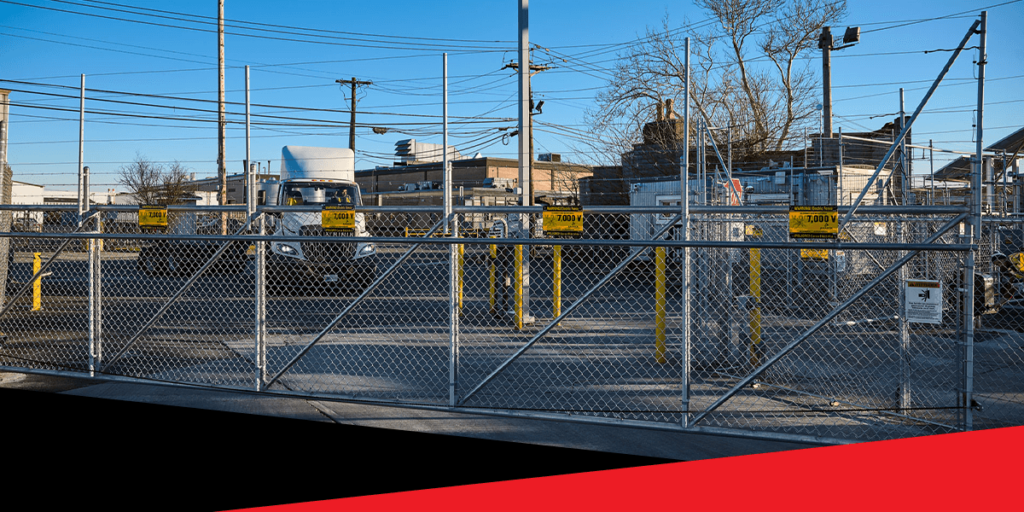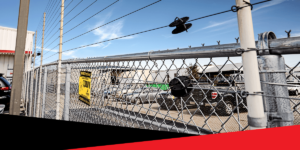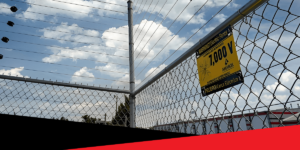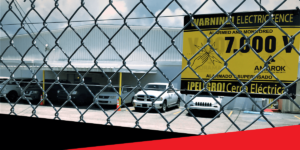If you own or manage a commercial property, you know the challenges of trying to keep would-be thieves off your lot. The hard truth is that passive security measures aren’t enough. Cameras may give you footage, but you don’t just want to record the crime — you want to prevent it.
Knowing your property’s weak spots helps you create strong, multi-layered defenses that combine electric fencing with physical security, technology, and staff awareness. This approach keeps your site less attractive to criminals, reducing the odds of an attempted breach and preventing commercial theft.
The Impacts of Commercial Property Theft
Thieves often break in after hours to steal equipment, tools, vehicles, or company assets. Similarly, warehousing and logistics operations often face cargo theft, where targeted items include food, electronics, and beverages, while vacant sites and utility areas may be hit for valuable materials like copper and other metals. Theft adds up quickly, leading to consequences that include:
- Lost productivity: Equipment theft, copper wire stripping, or damaged machinery stalls operations, impacting revenue and reputation.
- Rising insurance premiums: Multiple claims often result in higher rates or canceled policies.
- Legal liability: Businesses that fail to secure their premises may face legal exposure if a crime leads to injury or data theft.
- Unsafe working environments: Employees often feel uneasy returning to a site that’s been hit more than once. They may hesitate to work early or late shifts, affecting productivity and morale.
- Customer loss: Missed delivery windows or production delays put contracts at risk and potentially damage long-term business relationships.
Thieves often damage property by breaking windows or destroying fixtures to reach their targets, and vandals deliberately cause harm to the premises or valuable resources on-site. Between the lost property and the cost of repairing any damage, the impacts of commercial theft can be profound.
Understanding How Criminals Gain Access to Your Property
Commercial properties face a wide range of constant and evolving threats. In 2023, there were 6.42 million reported property crimes in the U.S., making proactive security a necessity. The problem is that most criminals aren’t planning complex robberies. Instead, they take advantage of easy opportunities. A thief notices a dark corner, a gap in the fence, or valuable equipment left out overnight. They act fast, grabbing what they can and disappearing before anyone notices.
Catalytic converter theft increased by 900% between 2019 and 2023 because these components are quick to steal and sell. Thieves can get between $20 and $350 for stolen catalytic converters, while vehicle owners pay over $2,500 on average to replace them. Copper, which increased in value by 30% over the last five years, is another popular target, as are heavy equipment and even stored fuel. Common vulnerabilities that provide access points to thieves include:
- Weak perimeter security: Open areas with no clear boundaries, fencing with gaps, low height, and a lack of electric fencing make it easy for intruders to enter your premises.
- Poor lighting: Dark areas make it harder for cameras and staff to see what’s happening, giving thieves a chance to operate unseen.
- Unsecured access points: Perimeter gates that lack specialized locks and are accessible without credential readers give criminals easy entrance to your property.
- Remote locations: Warehouses, construction sites, and satellite offices may have irregular foot traffic. Without consistent monitoring, these sites become attractive targets for theft or vandalism.
- Outdoor storage: Tools, equipment, and inventory stored outside are often left unprotected or only lightly fenced. Without strong barriers, these assets are vulnerable to theft.
How to Proactively Keep Criminals off Your Property
Proactive protection makes your property harder to break into and easier to monitor, improving your overall security posture. This approach to security reduces risk, protects assets, and creates a safer work environment. Here are four steps you can take to build a strong perimeter defense:
Step 1: Assess Your Vulnerabilities
Start with a full site assessment that covers common vulnerable areas such as:
- Perimeters: Fences, gates, and walls serve as a property’s first line of defense, so they must be in good repair. Gaps, broken locks, and poor lighting invite intrusion.
- Delivery zones: Loading docks and delivery zones are active spaces with high foot and vehicle traffic, making it easy for criminals to blend in as they scope out the area.
- Parking lots: Lack of surveillance and poor lighting make parking areas high-risk zones, especially at night.
- Back entrances: Service doors and back entrances often receive less oversight because they are not used by customers. Criminals exploit that by using them as points to force entry.
- Storage areas: Vacant units and storage areas on a property are often underused — and therefore overlooked. That makes them common targets for repeated theft or squatting.
Step 2: Implement Proactive Security Measures
A multi-layered security strategy is the best way to minimize the risk of a breach, and it starts with a strong perimeter fence as the foundation of your security strategy. Physical barriers, signage, and access control systems work well together, as each layer adds protection and delays potential intruders.
Start by securing your perimeter. Add an electric fence inside your existing fencing, with gates that limit vehicle access during off-hours. Next, deploy surveillance cameras with remote access that allow you to monitor your defenses.
Step 3: Build a Security-Conscious Culture
Train employees to spot suspicious behavior, report incidents, and follow access control procedures. Limit after-hours access to essential personnel only and encourage staff to take ownership of security, especially in high-risk zones like loading docks.
Step 4: Ongoing Reviews and Updates
As crime evolves, you must review and test your systems regularly. Audit camera footage, run test scenarios on protecting high-value stock, and conduct regular perimeter checks. Make security reviews part of your operational calendar and update protocols after an attempted breach.
Frequently Asked Questions
Commercial property managers often ask similar questions as they start a new security strategy. The following are some of the most common inquiries, coupled with clear guidance to help you move forward with confidence:
What Are the Elements of Multi-Layered Perimeter Security?
The measures involved in a multi-layered security system differ depending on each site’s unique needs. Generally, though, you are looking at these elements:
- Electric fencing: Effective electric fencing is a powerful crime deterrent for multiple industries, as the visual presence alone tells intruders the site is protected. Should someone attempt to breach the fence, it delivers a safe but memorable pulsed electric shock.
- Video surveillance: An electric fence paired with a video surveillance system provides 24/7 property protection. Criminals may be less likely to act if they know there will be video evidence of their activities.
- Gate Access Control: Logistics operations and truck yards in particular benefit from Gate Access Control systems, which can include credential readers, license plate recognition, and AI cameras. Merging access management with the electric fence ensures that only authorized personnel enter the premises.
- Alarm-based lighting: Criminals favor dark, isolated areas that give them anonymity, and a well-lit perimeter reduces concealment opportunities. An electric fence that triggers an alarm-based lighting system is excellent for calling attention to attempted breaches, as it will flood the area with light to reveal criminal activity and alert security.
What Activates the Electric Fence?
If the electric fence’s voltage drops, it goes into alarm mode and notifies the central monitoring station. The fence also delivers a safe but memorable 7,000-volt pulse every 1.3 seconds to further deter thieves. This voltage-based trigger setup reduces the likelihood of false alarms, ensuring the electric fence is not activated by vegetation or small animals.
What Does the Return on Investment Look Like for Perimeter Security?
You have zero upfront costs when you partner with the right perimeter security service provider. A security-as-a-service model means that their team handles installation and maintenance — all your business pays is a manageable monthly fee. With AMAROK, you see an average of up to five times your return on investment when you protect your operations and critical assets with multi-layered perimeter security.
Get Proactive Perimeter Security With AMAROK
When you take steps to protect your assets, criminals notice. Over time, you will see more financial stability and improved morale thanks to employees feeling more secure in the workplace. Proactive business security prevents theft, helps your business stay in control, protects your people, and supports long-term stability.
AMAROK is an award-winning perimeter security solutions provider. Our flagship product, The Electric Guard Dog™ Fence, integrates with our diverse selection of other solutions to create a comprehensive security strategy. The solar-powered electric fence operates continuously even during a power outage to ensure you’re never left vulnerable. Across 49 states, 99% of our customers experience no external theft after installation.
Protect your bottom line with our multi-layered security system. Talk to your local AMAROK security expert today for a free threat assessment.




